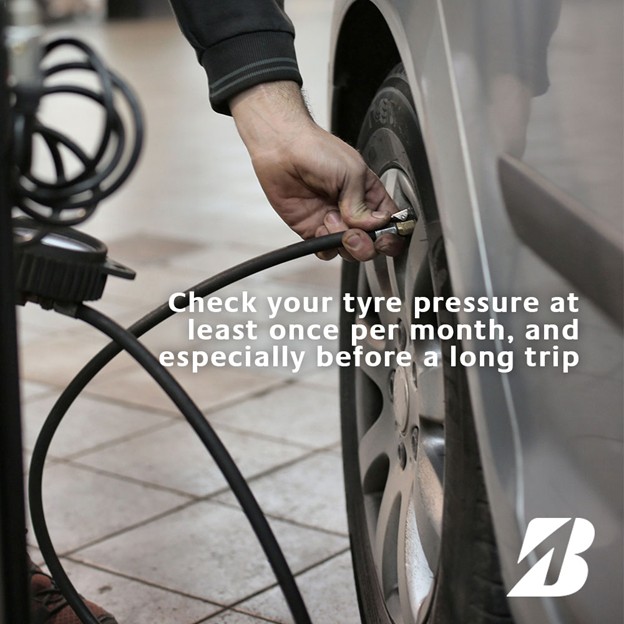Tyre Pressure - Impact on Your Driving Comfort and Control

Picture yourself cruising along a wet road and you begin to sense your vehicle sliding as you hit the brakes. Or perhaps your drives have become noticeably bumpier, especially when navigating road imperfections. If you relate to these scenarios, it’s possible that you have improperly inflated tyres. To avoid these issues and prioritise your safety, it’s advised to maintain properly inflated tyres for optimal vehicle performance. This is why checking tyre pressure is such an important part of your regular car maintenance routine. Let’s explore how properly inflated, underinflated and overinflated tyres can affect your driving comfort and control.
Properly Inflated Tyres
Tyre pressure is measured in PSIs (Pound Per Square Inch), and all vehicles have their own recommended PSI value that must be adhered to. You can find this value in the vehicle owner’s manual or by referring to the sticker on the driver’s door. Getting your tyre pressure checked should be done monthly and all it takes is a tyre pressure gauge. When inflated at their recommended tyre pressure value, these tyres offer optimum traction for better handling and comfort on different road conditions. This makes it easier to navigate wet or bumpy roads, especially when performing emergency maneuvers[TY1] [VV2] [TY3] to avoid accidents. However, the same cannot be said about underinflated tyres.
Underinflated Tyres
After countless drives, [TY4] you might notice your tyres looking a little more deflated than they should be—or sometimes you may not notice at all. Busy schedules can make it easy to put off inflating your tyres, but delaying this is never advisable. Underinflated tyres lose the proper shape needed to grip the road, which reduces traction and stability while you drive. This can lead to longer braking distances, making it harder to stop your vehicle in time, especially on wet roads where the risk of skidding increases. Keeping your tyres properly inflated not only ensures a safer and more stable drive but also helps maintain braking performance and overall vehicle control.
Overinflated Tyres
Inflating your tyres above its recommended PSI value almost guarantees you a bumpier ride due to decreased shock absorption. These tyres are then less likely to offer you sufficient traction, commonly bouncing off road surfaces. This will then affect your vehicle’s stability as excessive vibrations may be transmitted to the steering wheel. With your driving comfort and control compromised, you’ll also be exposed to the risk of these tyres blowing out. Compressing excessive air pressure in your tyres makes them more susceptible to punctures from sharp objects on the road. This is why experts often compare overinflated tyres to that of a bouncing ball. Overinflated tyres are not only a safety risk but are also more susceptible to tyre puncture from road debris. So, don’t overthink it – follow your vehicle’s recommended PSI value and you’re good to go.
How Tyre Pressure Affects Hydroplaning
Driving in the rain on wet roads can cause hydroplaning—where your tyres tend to glide across the film of water on the road. In this instance, your tyres lose their grip on the road, making it harder for you to control your vehicle. Improperly inflated tyres can significantly increase the risk of hydroplaning. Underinflated tyres have less contact with the road, reducing their ability to grip and channel water away. On the other hand, overinflated tyres may not provide enough contact with the road, increasing the chances of hydroplaning. To reduce the risk of hydroplaning, here are some important tips:
· Check your tyre pressures at least once a month [TY1] and ensure they are properly inflated
· Ensure your tyres are [TY2] regularly aligned and rotated
· Avoid driving through puddles of water
· Ensure your tyre tread depth [TY3] is always above the minimum legal limit of 1.6mm
· Always maintain a safe distance [TY4] from other vehicles, as braking distances tend to increase on wet roads.
· Remember to also schedule regular tyre rotation to ensure your tyres wear evenly and last longer..
Getting your tyres inflated at just the right air pressure value will do wonders for your driving comfort and control. Properly inflated tyres offer better traction and handling, while underinflated or overinflated tyres can compromise control, stability, and increase the risk of damage. Before we sign off, here’s a friendly reminder to always stay aware of your tyre's condition and prioritise regular maintenance for smoother, safer drives.
Explore our tyre catalogue to get the best Bridgestone tyres for all your driving activities.